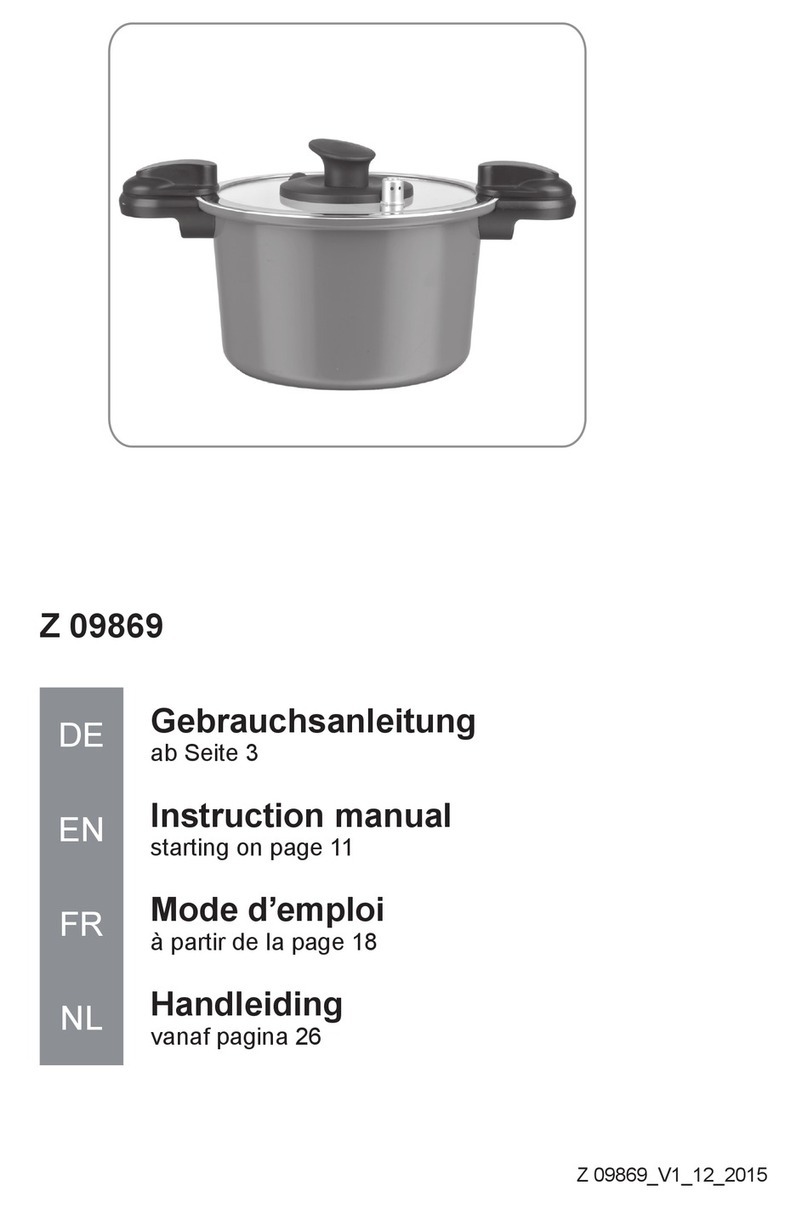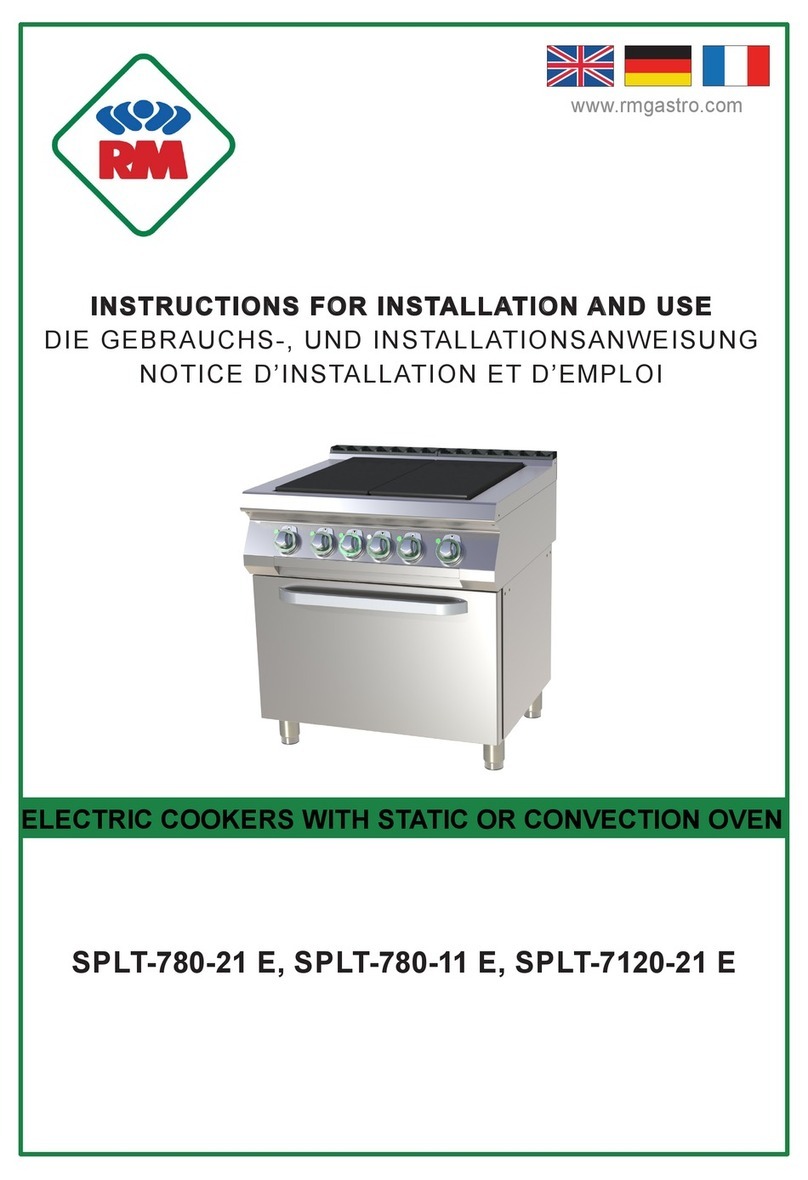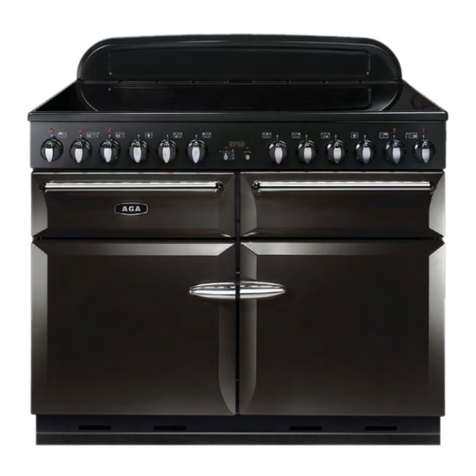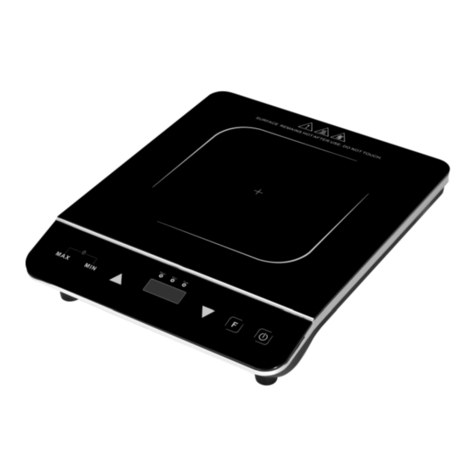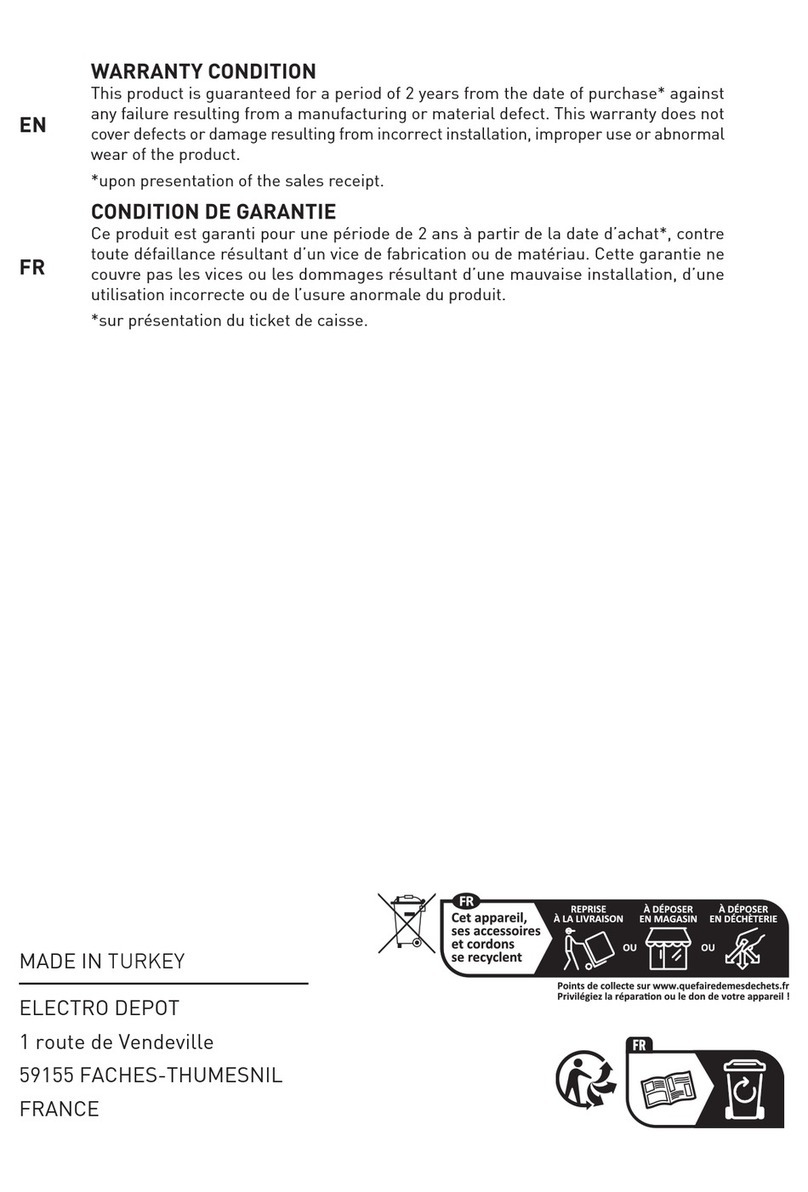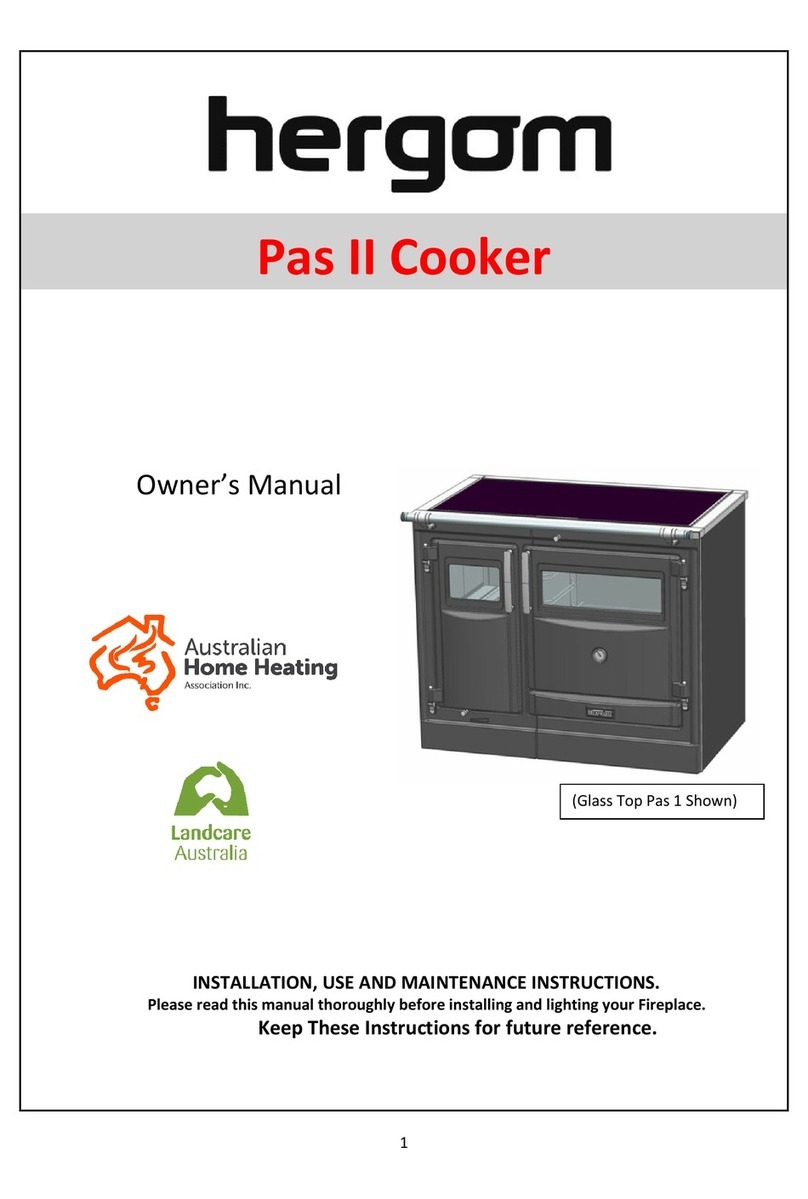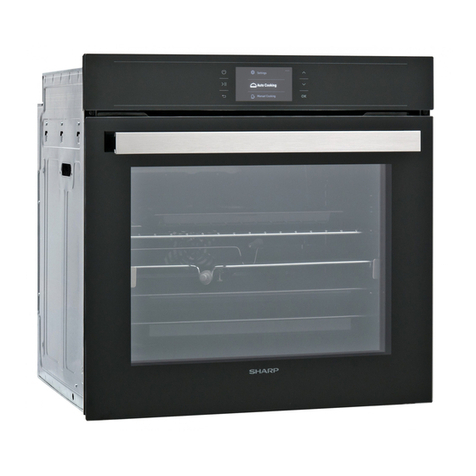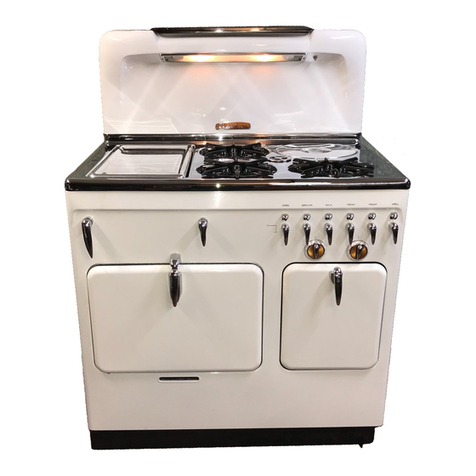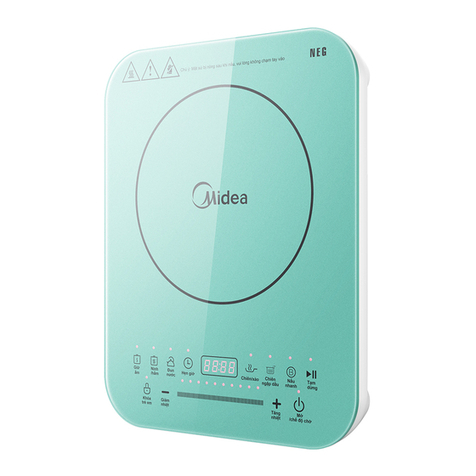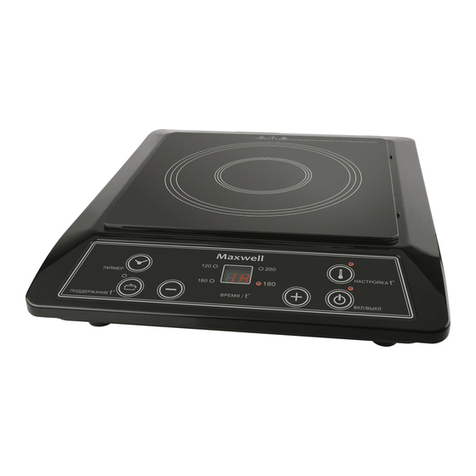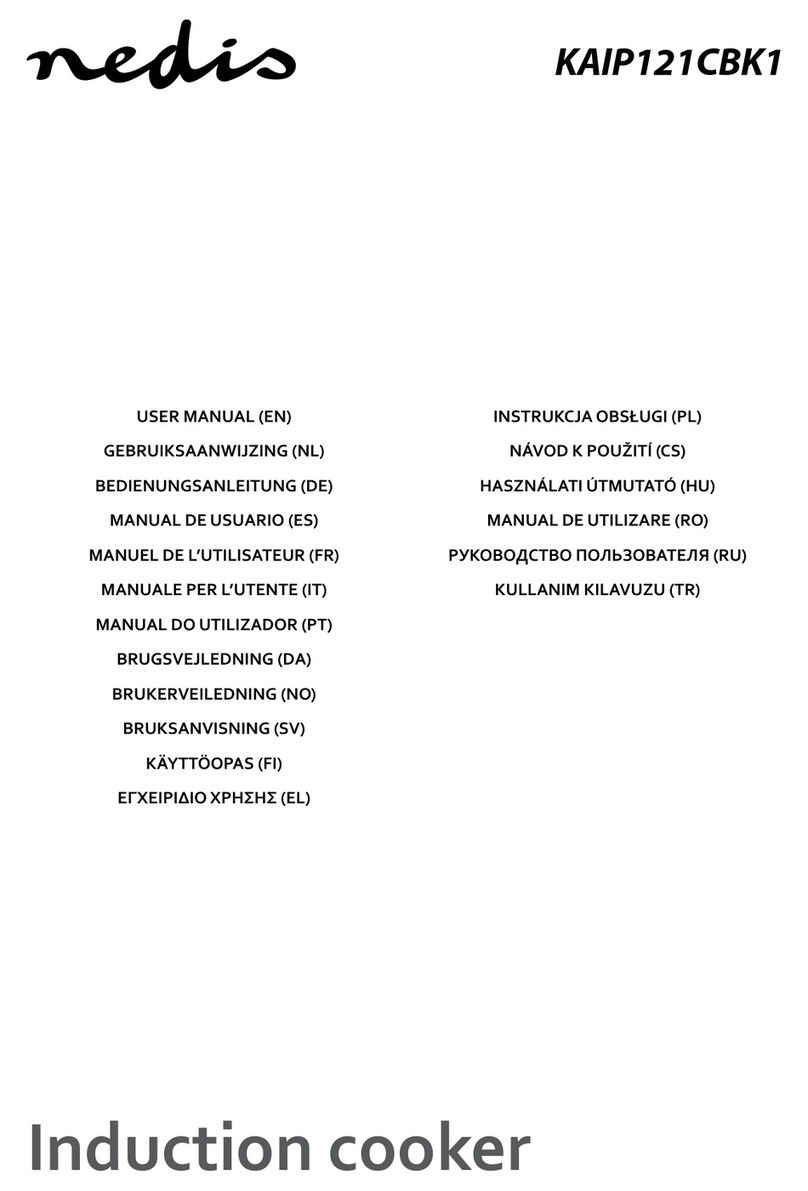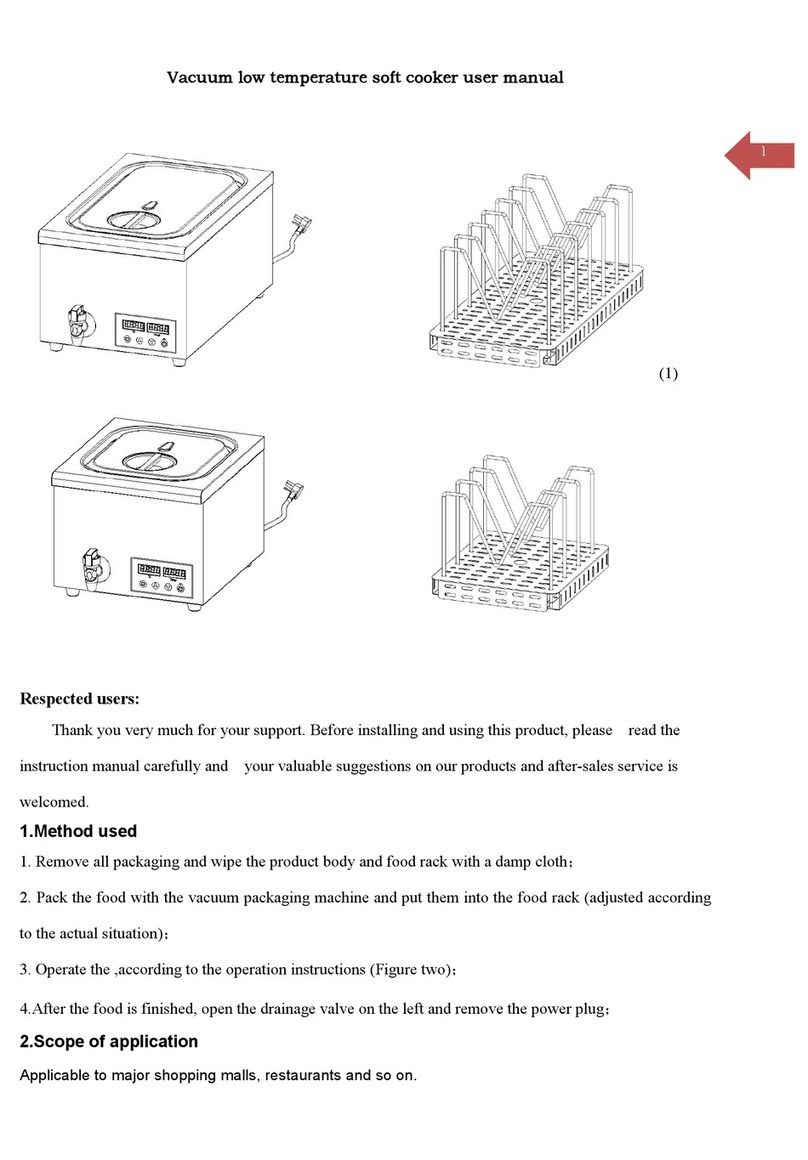DS Produkte CK-S93120 User manual

Z 01207_V3_07_2015
Z 01207
DE Gebrauchsanleitung
ab Seite 3
EN Instruction manual
starting on page 11
FR Mode d’emploi
à partir de la page 19
NL Handleiding
vanaf pagina 27

DE 2

3 DE
Sehr geehrte Kundin, sehr geehrter Kunde,
wir freuen uns, dass Sie sich für diesen Kochtopf entschieden haben.
Lesen Sie vor dem ersten Gebrauch des Artikels die Anleitung sorgfältig durch und
bewahren Sie sie zum späteren Nachlesen auf. Bei Weitergabe des Artikels ist auch
diese Anleitung mitzugeben. Hersteller und Importeur übernehmen keine Haftung,
wenn die Angaben in dieser Anleitung nicht beachtet werden.
Sollten Sie Fragen zum Gerät sowie zu Ersatz- /Zubehörteilen haben, kontaktieren
Sie den Kundenservice über unsere Webseite:
www.service-shopping.de
Bestimmungsgemäßer Gebrauch
• Der Kochtopf eignet sich zum Garen von Speisen ohne Überdruck (max. 0,04 bar).
Der Kochtopf eignet sich nicht zum Dampfdruckgaren, er ist kein Schnellkochtopf.
• Der Kochtopf ist für alle Herdarten (Induktion, Elektro, Gas, Ceran) geeignet. Ver-
wenden Sie ihn nicht auf anderen Heizquellen.
• Bereiten Sie keine Kompotte, Apfelmus oder ähnliches mit dem Kochtopf zu.
• Stellen Sie den Kochtopf niemals in einen eingeschalteten Backofen. Griffe und
Ventile können durch die hohen Temperaturen beschädigt werden.
• Der Kochtopf ist nicht zur Verwendung in der Mikrowelle geeignet.
• Der Kochtopf darf nicht im medizinischen Bereich eingesetzt werden. Insbesondere
nicht als Sterilisator, da der Kochtopf nicht für die erforderliche Sterilisationstempe-
ratur ausgelegt ist.
• Der Kochtopf ist für den Privatgebrauch, nicht für eine gewerbliche Nutzung bestimmt.
• Nutzen Sie den Kochtopf nur wie in der Anleitung beschrieben. Jede weitere Ver-
wendung gilt als bestimmungswidrig.
Inhalt
Bestimmungsgemäßer Gebrauch __________ 3
Sicherheitshinweise _____________________ 4
Lieferumfang ___________________________ 6
Artikelübersicht ________________________ 6
Vor dem ersten Gebrauch_________________ 6
Sicherheitseinrichtungen im Kochdeckel _____ 7
Deckel öffnen und schließen_______________ 7
Benutzung _____________________________ 8
Reinigung und Aufbewahrung______________ 9
Fehlerbehebung _______________________ 10
Technische Daten ______________________ 10
Entsorgung ___________________________ 10
Symbolerklärung
Sicherheitshinweise:
Lesen Sie diese aufmerk-
sam durch und halten Sie
sich an sie, um Personen-
und Sachschäden zu ver-
meiden.
Ergänzende Informationen

DE 4
• Von der Gewährleistung ausgeschlossen sind alle Mängel, die durch unsachgemäße
Behandlung, Beschädigung oder Reparaturversuche entstehen. Dies gilt auch für den
normalen Verschleiß.
Sicherheitshinweise
Verletzungsgefahren
• Halten Sie Kinder und Tiere vom Kochtopf und Verpackungsmaterial fern.
• Lassen Sie den Kochtopf während des Gebrauchs nicht unbeaufsichtigt.
• Verbrühungsgefahr! Aus den Ventilen tritt heißer Dampf aus! Halten Sie Gesicht und
Hände immer aus dem Bereich der Ventilaustrittsöffnungen fern!
• Verbrühungsgefahr! Seien Sie vorsichtig beim Öffnen des Deckels, heißer Dampf
entweicht aus dem Inneren des Topfes.
• Seien Sie vorsichtig bei der Benutzung des Kochtopfs. Eine unsachgemäße Benut-
zung kann zu Verbrennungen führen. Vergewissern Sie sich vor dem Kochvorgang,
dass der Kochtopf korrekt verschlossen ist.
• Der Kochtopf darf nur unter Beachtung von folgenden Vorsichtsmaßnahmen trans-
portiert werden:
–Berühren Sie nie die heißen Flächen des Kochtopfs. Fassen Sie ihn an den Griffen
an. Benutzen Sie gegebenenfalls Topfhandschuhe.
–Heben Sie den Kochtopf niemals am Deckelgriff hoch.
–Halten Sie den Topf immer waagerecht und stellen Sie ihn vorsichtig hin. Schieben,
ziehen, stoßen oder werfen Sie den Topf nicht!
–Halten Sie den Kochtopf immer an beiden Handgriffen fest, wenn Sie ihn bewegen!
Gesundheitsspezifische Sicherheitshinweise
• Der Artikel kann mit Produktionsrückständen behaftet sein. Reinigen Sie den Koch-
topf, den Abgießdeckel und den Deckel vor dem ersten Gebrauch. Beachten Sie dazu
die Hinweise in den Kapiteln „Vor dem ersten Gebrauch“ und „Reinigung und Aufbe-
wahrung“.
Der richtige Gebrauch
• Überprüfen Sie vor jedem Gebrauch die einwandfreie Funktionsfähigkeit des Kochtop-
fes, der Deckelverschlüsse und der Ventile. Benutzen Sie den Topf nicht, wenn Topf,
Deckel, Abgießdeckel oder die Ventile Schäden aufweisen oder verstopft sind.
• Halten Sie die Ventile, die Deckel und den Kochtopf vor und nach dem Gebrauch
sauber. Halten Sie alle Teile frei von Verunreinigungen und Fettschmutz (siehe Ka-
pitel „Reinigung und Aufbewahrung“).
• Sollte der Kochtopf, die Ventile, die Deckel oder die Deckelverschlüsse defekt sein, ver-
wenden Sie den Kochtopf nicht und versuchen Sie nicht, Schäden selbst zu reparieren.
Wenden Sie sich in Schadensfällen an einen Fachmann oder an den Kundenservice.
• Verwenden Sie nur vom Hersteller empfohlene Ersatz- oder Zubehörteile, die zum
jeweiligen Modell passen.

5 DE
• Nehmen Sie an den Ventilen keinerlei Eingriffe vor, mit Ausnahme der Maßnahmen,
die im Kapitel „Reinigung und Aufbewahrung“ beschrieben werden.
• Achten Sie darauf, dass die Ventile während des Gebrauchs nicht von anderen Ge-
genständen (z.B. Topflappen) abgedeckt werden!
• Ziehen oder schieben Sie den Kochtopf nicht über Glaskeramikkochfelder, um
Schäden am Kochfeld zu vermeiden.
• Benutzen Sie den Kochtopf nur auf stabilen Herden/Kochplatten. Achten Sie dar-
auf, dass die Kochplatte des Herdes nicht größer ist als der Durchmesser des Topf-
bodens! Achten Sie bei Gasherden insbesondere darauf, dass die Gasflamme nicht
über den Boden des Kochtopfes hinausschlägt. Die Flammen könnten den Topf oder
die Griffe beschädigen.
• Im Brandfall: Löschen Sie nicht mit Wasser, sondern ersticken Sie die Flammen mit
einer Löschdecke o.Ä.!
• Achten Sie darauf, dass die Flüssigkeit im Kochtopf während des Kochvorgangs
niemals vollständig verdampft. Wird die Hitzezufuhr nach dem Aufheizen nicht ver-
ringert, entweicht Dampf aus dem Dampfablassventil, wodurch sich die Flüssigkeits-
menge im Innern verringert. Ein vollständiges Verdampfen der Flüssigkeit führt zum
Anbrennen Ihrer Speisen und eventuell zu einer Beschädigung Ihres Kochtopfes.
• Vermeiden Sie ein Überhitzen. Durch Erwärmen in leerem Zustand oder durch restlo-
ses Verdampfen der Flüssigkeit kann das Material überhitzen und zu Materialschäden
sowie zu Rauchentwicklung führen. Schalten Sie in diesem Fall den Herd sofort aus,
nehmen Sie den Topf vom Herd und sorgen Sie für ausreichende Raumbelüftung.
• ACHTUNG Überhitzungsgefahr! Beachten Sie, dass die Aufheizgeschwindigkeit
von Induktionsherden höher ist als bei anderen Herdarten. Lassen Sie den Kochtopf
während der Benutzung nicht unbeaufsichtigt.
• Aufgrund der elektromagnetischen Eigenschaften von Induktionsherden und Induktions-
kochgeschirr kann es zu Geräuschentwicklungen kommen. Diese Geräusche sind tech-
nisch bedingt und stellen keinen Defekt des Herdes oder des Kochgeschirrs dar.
• Überprüfen Sie den Topfboden vor jeder Benutzung auf Beschädigungen! Verwen-
den Sie den Topf nicht, wenn sich Kratzer, Riefen oder Unebenheiten auf dem Topf-
boden befinden. Diese könnten das Kochfeld beschädigen.
• Schieben Sie den Topf nicht über das Kochfeld, es könnte zerkratzt werden.
• Verwenden Sie zum Braten und Kochen nur geeignete Koch- und Bratutensilien, wie
z.B. Pfannenwender oder Kochlöffel. Hinweis: Eine Verwendung von Metallküchen-
helfern ist möglich. Für eine besonders lange Lebensdauer Ihres Kochgeschirrs emp-
fehlen wir jedoch die Verwendung von Küchenhelfern aus Holz oder Kunststoff.
• Schütten Sie niemals kaltes Wasser in den Topf und auf die Deckel, wenn diese heiß
sind. Die Beschichtung könnte aufplatzen oder das Glas könnte zerspringen.
• Lassen Sie den Kochtopf und die Deckel nicht fallen und setzen Sie sie keinen star-
ken Stößen aus.

DE 6
Lieferumfang
• 1 Kochtopf
• 1 Deckel
• 1 Abgießdeckel
Artikelübersicht
1
2
3
6
4
5
1 Deckelgriff
2 Dampfablassventil
3 Deckelverschluss (1x pro Seite)
4 Kochtopf
5 Kochdeckel
6 Sicherheitsventil
Nicht abgebildet:
• Abgießdeckel
Vor dem ersten Gebrauch
Bevor Sie das Gerät benutzen können, müssen Sie:
• den Lieferumfang auspacken,
• Griff an Abgießdeckel montieren,
• Kochtopf und Deckel reinigen (siehe Kapitel „Reinigung und Aufbewahrung“).
Auspacken
ACHTUNG!
• Halten Sie Kinder und Tiere vom Verpackungsmaterial fern. Es besteht Erstickungs-
gefahr!
1. Packen Sie alle Teile aus und überprüfen Sie den Lieferumfang auf Vollständigkeit (siehe
Kapitel „Lieferumfang“) und Transportschäden. Falls die Bestandteile Schäden aufwei-
sen sollten, verwenden Sie diese nicht(!), sondern kontaktieren Sie den Kundenservice.
2. Reinigen Sie den Kochtopf und die Deckel vor dem ersten Gebrauch mit warmem Was-
ser und etwas mildem Spülmittel, um eventuelle Produktionsrückstände zu beseitigen.
Beachten Sie dazu auch die Hinweise im Kapitel „Reinigung und Aufbewahrung“.

7 DE
Abgießdeckel montieren
1. Haken Sie ein Ende des Griffs in den Abgießedeckel ein.
2. Schrauben Sie das andere Ende des Griff mit Hilfe der
Schraube, der Gummidichtung und der Unterlegscheibe
fest.
Sicherheitseinrichtungen im Kochdeckel
ACHTUNG!
• Achten Sie darauf, dass die Ventile niemals durch andere Gegenstände (z.B. Topf-
lappen) abgedeckt werden.
Der Kochtopfdeckel verfügt über verschiedene Sicherheitseinrichtungen:
–Dampfablassventil
–Sicherheitsventil
Dampfablassventil
Damit kein Überdruck im Inneren des Kochtopfes aufgebaut werden kann, lässt
das Dampfablassventil automatisch Dampf ab. Wenn im Inneren Druck aufgebaut
wird, steigt der Ventilkopf automatisch nach oben und überschüssiger Dampf kann
entweichen. So wird der Innendruck auf max. 0,04 bar gehalten. Sobald Dampf aus
dem Dampfablassventil austritt, können Sie die Hitzezufuhr etwas reduzieren.
Sicherheitsventil
Das Sicherheitsventil ist ein zusätzliches Sicherheitselement, das im Deckel
eingearbeitet ist. Sollte das Druckablassventil verstopft und/oder defekt sein, wird
Dampf über das Sicherheitsventil abgelassen und der Innendruck auf einem niedrigen
Niveau gehalten. Sollte dieser Fall eintreten, unterbrechen Sie sofort die Hitzezufuhr
und nehmen Sie den Kochtopf vom Herd. Warten Sie, bis sich der Kochtopf abgekühlt
hat. Überprüfen Sie die Ventile und reinigen Sie sie gegebenenfalls (siehe Kapitel
„Reinigung und Aufbewahrung“). Fahren Sie mit dem Kochvorgang nur fort, wenn der
Kochtopf, der Deckel und die Ventile voll funktionsfähig sind!
1
2

DE 8
Deckel öffnen und schließen
ACHTUNG!
• Achten Sie immer darauf, dass Sie den Deckel mit beiden Deckelverschlüssen fixieren.
1. Setzen Sie den Kochdeckel/Abgießdeckel auf den Topf.
2. Drehen Sie beide Deckelverschlüsse über den Deckelrand,
so dass der Kochdeckel/Abgießdeckel fest fixiert ist.
3. Zum Abnehmen des Kochdeckels/Abgießdeckels drehen
Sie beide Deckelverschlüsse weg vom Deckel, so dass die
Verschlüsse nicht mehr auf dem Deckelrand liegen.
Benutzung
ACHTUNG!
• Überprüfen Sie vor jeder Inbetriebnahme die Funktionsfähigkeit von Topf, Deckel
und Ventilen!
• Lassen Sie den Kochtopf während des Kochens niemals unbeaufsichtigt!
• Halten Sie Kinder und Tiere während der Benutzung vom Kochtopf fern!
• Achten Sie darauf, dass die Ventile während der Benutzung niemals abgedeckt sind.
• Überfüllen Sie den Kochtopf nicht und achten Sie darauf, dass immer ausreichend
Flüssigkeit im Kochtopf vorhanden ist.
• Verbrühungsgefahr! Aus den Ventilen tritt heißer Dampf aus! Halten Sie Gesicht und
Hände immer aus dem Bereich der Ventilaustrittsöffnungen fern!
• Unterbrechen Sie die Hitzezufuhr sofort, wenn Dampf aus dem Sicherheitsventil
austritt! Verwenden Sie den Kochtopf erst wieder nach Beseitigung der Störung!
• Verbrühungsgefahr! Seien Sie vorsichtig beim Öffnen des Deckels, heißer Dampf
entweicht aus dem Inneren.
Sicherheitseinrichtungen überprüfen
1. Vergewissern Sie sich, dass sowohl der Dichtungsring im Kochdeckel als auch der
Kochdeckel selbst vollkommen sauber sind.
2. Vergewissern Sie sich, dass der Dichtungsring korrekt im Kochdeckel sitzt.
3. Vergewissern Sie sich, dass die Ventile im Kochdeckel sauber und nicht blockiert sind.
Garvorgang
1. Geben Sie Ihre Speisen in den Kochtopf. Achten Sie darauf, das ausreichend Flüs-
sigkeit bzw. Öl oder Fett im Kochtopf vorhanden ist.
2. Setzen Sie den Deckel auf den Kochtopf und verschließen ihn. Achten Sie immer
darauf, dass Sie den Deckel mit beiden Deckelverschlüssen fixieren.
3. Stellen Sie den Kochtopf auf eine geeignete Herdplatte.

9 DE
4. Stellen Sie die Kochplatte bzw. das Kochfeld auf eine hohe Temperatur ein, um den
Kochtopf aufzuheizen.
Hinweis:
–Wenn Sie einen Elektroherd benutzen, darf die Kochplatte nicht größer sein, als
der Topfboden.
–Wenn Sie einen Gasherd benutzen, dürfen die Flammen nicht über den Topfboden
hinausschlagen!
5. Sobald die Temperatur im Inneren des Kochtopfes hoch genug ist und der Innendruck
etwas ansteigt, wird automatisch Dampf über das Dampfablassventil abgelassen.
6. Reduzieren Sie die Hitzezufuhr, sobald Dampf aus dem Dampfablassventil austritt
(ab diesem Zeitpunkt wird die Kochzeit berechnet). Wenn während des Garvor-
gangs gar kein Dampf mehr aus dem Dampfablassventil austritt, überprüfen Sie, ob
sich noch genügend Flüssigkeit/ Öl /Fett im Kochtopf befindet und erhöhen Sie ggf.
die Wärmezufuhr.
7. Schalten Sie nach Ablauf der Garzeit die Kochplatte aus und nehmen Sie den Koch-
topf vom Herd.
8. Öffnen Sie den Deckel, indem Sie die Deckelverschlüsse vom Deckelrand weg drehen.
9. Nehmen Sie den Deckel vom Kochtopf. Seien Sie vorsichtig, es entweicht heißer Dampf!
10. Wenn Sie Kochwasser abgießen möchten, können Sie
den Abgießdeckel aufsetzen und das Kochwasser durch
die Öffnungen im Deckel abgießen.
ACHTUNG Verbrühungsgefahr: Achten Sie
darauf, dass der Abgießdeckel korrekt mit den
Deckelverschlüssen fixiert ist, damit er beim
Ausgießen nicht abfallen kann und das heiße
Kochwasser unkontrolliert herausfließt!
11. Entnehmen Sie Ihre Speisen.
12. Reinigen Sie den Kochtopf und die Deckel nach jedem Gebrauch (siehe Kapitel
„Reinigung und Aufbewahrung“)
Reinigung und Aufbewahrung
ACHTUNG!
• Bewahren Sie keine Lebensmittel im Topf für eine längere Zeit auf.
• Reinigen Sie den Kochtopf und die Deckel nach jedem Gebrauch!
• Überprüfen Sie vor und nach jedem Gebrauch die Sicherheitseinrichtungen im
Kochdeckel!
• Verwenden Sie zum Reinigen keine ätzenden oder scheuernden Reinigungsmittel.
Diese können die Oberfläche beschädigen.
1. Reinigen Sie den Kochtopf und den Abgießdeckel mit warmem Wasser und mildem
Spülmittel. Trocknen Sie den Kochtopf gründlich ab, bevor Sie ihn verstauen.
2. Nehmen Sie den Dichtungsring aus dem Kochdeckel heraus.

DE 10
3. Reinigen Sie den Kochdeckel und den Dichtungsring mit warmen Wasser und mil-
dem Spülmittel. Setzen Sie den Dichtungsring erst wieder ein, wenn Deckel und
Dichtungsring vollständig getrocknet sind.
4. Die Ventile sollten immer sauber und frei von Rückständen jeglicher Art sein. Sollte
ein Ventil verstopft sein, entfernen Sie eventuelle Rückstände mit einem Zahnstocher.
5. Der Kochdeckel und der Dichtungsring sind nicht spülmaschinengeeignet.
6. Bewahren Sie alle Teile an einem trockenen und sauberen Ort auf!
Fehlerbehebung
Sollte der Artikel nicht ordnungsgemäß funktionieren, überprüfen Sie zunächst, ob Sie
ein Problem selbst beheben können. Versuchen Sie nicht, den Kochtopf eigenhändig zu
reparieren, wenn er defekt ist! Kontaktieren Sie in diesem Fall den Kundenservice.
Problem Mögliche Ursache Lösung
Am Deckel tritt
Dampf aus bzw.
Wasser tropft aus
dem Deckelrand.
• Der Dichtungsring ist
verunreinigt bzw. nicht
korrekt eingesetzt.
• Der Dichtungsring ist be-
schädigt.
• Der Deckel ist nicht
korrekt verschlossen.
• Die Ventile sind verunrei-
nigt.
• Reinigen Sie den Dichtungsring
und achten Sie beim Einlegen
auf den korrekten Sitz des
Dichtungsringes.
• Ersetzen Sie den Dichtungs-
ring.
• Setzen Sie den Deckel erneut
auf und verschließen Sie ihn
mit beiden Deckelverschlüs-
sen.
• Reinigen Sie die Ventile
(siehe Kapitel „Reinigung und
Aufbewahrung“).
Technische Daten
Modell: CK-S93120
Artikelnummer: Z 01207
Betriebsdruck: max. 0,025 bar
Kapazität: 6 l
Für Lebensmittel geeignet.
Entsorgung
Das Verpackungsmaterial ist wiederverwertbar. Entsorgen Sie die Verpackung
umweltgerecht und führen Sie sie der Wertstoffsammlung zu. Entsorgen Sie
auch den Artikel umweltgerecht. Nähere Informationen erhalten Sie bei Ihrer
örtlichen Gemeindeverwaltung.
Kundenservice/Importeur:
DS Produkte GmbH
Am Heisterbusch 1
19258 Gallin
Deutschland
Tel.: +49 38851 314650
(0 – 30 Ct./Min. aus dem dt.
Festnetz, Kosten variieren je nach
Anbieter.)
Alle Rechte vorbehalten.

11 EN
Dear customer,
We are delighted that you have decided on this pot.
Before using the product for the first time, please carefully read through the instructions
and store them for future reference. These instructions are to accompany the product
when passed on to others. The manufacturer and importer assume no liability in the
event the data in these instructions have not been observed!
If you have questions about the device or spare parts/accessories, contact customer
service via our website:
www.service-shopping.de
Proper use
• The pot is suitable for cooking foods without overpressure (max. 0.04 bar). The pot is
not suitable for steam cooking; it is not a pressure cooker.
• The pot is suitable for all stove types (induction, electric, gas, Ceran). Do not use it
on other heat sources.
• Do not use the pot to prepare compote, apple sauce or similar dishes.
• Never place the pot in an oven when it is on. The high temperatures could damage
the handles and valves.
• The pot is not suitable for use in the microwave.
• The pot may not be used for medical applications. In particular, it may not be used as a
steriliser as the pot is not designed to withstand the required sterilisation temperature.
• The pot is designed for private use and is not intended for commercial use.
• Only use the pot as instructed. Any other use is deemed improper.
• Defects arising due to improper handling, damage or attempts at repair are excluded
from the warranty. This also applies to normal wear and tear.
Content
Proper use ___________________________ 11
Safety notes___________________________ 12
Product contents _______________________ 14
Product overview ______________________ 14
Before first use ________________________ 14
Safety devices in the cooking lid ___________ 15
Opening and closing the lid _______________ 16
Use _________________________________ 16
Cleaning and storage ___________________ 17
Troubleshooting________________________ 18
Technical data _________________________ 18
Disposal______________________________ 18
Explanation of
symbols
Safety instructions:
Please carefully read
through and obey the safe-
ty notes in order to avoid
injury to persons and dam-
age to property.
Supplementary information

EN 12
Safety notes
Risks of injury
• Keep children and animals away from the pot and the packaging material.
• Do not leave the pot unattended when in use.
• Scalding hazard! Hot steam is emitted from the valves! Always keep your face and
hands away from the area around the valve vents!
• Scalding hazard! Be careful when opening the lid, hot steam is released from the
inside of the pot.
• Be careful when using the pot. Improper use may cause burns. Make sure that the
pot is correctly closed when cooking.
• The pot may only be transported if the following safety measures are taken:
–Never touch the hot surfaces of the pot. Take hold of it by the handles. Use oven
mitts if applicable.
–Never use the handle on the lid to lift the pot.
–Always keep the pot in a level position and set it down carefully. Do not slide, pull,
bump or throw the pot!
–Always use both handles to hold the pot firmly when moving it!
Health safety notes
• Some production residues may be stuck to the product. Clean the pot, the drain lid
and the lid before first use. For this, observe the notes in the chapters “Before first
use” and “Cleaning and storage”.
Proper use
• Each time before you use the pot, check that the pot, the lid closures and the valves
are in proper functioning order. Do not use the pot if the pot, lid, drain lid or the valves
are damaged or plugged.
• Keep the valves, lids and the pot clean before and after use. Keep all parts free of
soiling and greasy dirt (see chapter “Cleaning and storage”).
• If the pot, the valves, the lids or the lid closures are defective, do not use the pot and
do not attempt to repair damages yourself. In the event of damage, contact a profes-
sional or customer service.
• Only use the spare parts or accessories recommended by the manufacturer, which
fit the respective model.
• With the exception of the measures described in the chapter “Cleaning and storage”,
do not tamper with the valves at all.
• Make sure that the valves are not covered by other objects (e.g. potholders) during use!
• Do not push or pull the pot across glass ceramic hobs to prevent damage to the hob.
• Only use the pot on stable stoves/hotplates. Make sure that the hotplate is not larger
than the diameter of the bottom of the pot! With gas stoves, be particularly sure that
the gas flames do not lick up along the sides of the pot. The flames could damage
the pot or the handles.
• In case of fire: Do not extinguish the flames with water; instead smother them with a
fire blanket or similar!

13 EN
• Make sure that liquid in the pot never completely evaporates while cooking. If the heat
supply is not reduced after heating up the pot, steam will be released from the steam
release valve reducing the amount of liquid in the pot. If the liquid completely evapo-
rates, your food will burn onto the pot and potentially damage the pot as a result.
• Avoid overheating. If you heat up an empty pot or allow the liquid to vaporise com-
pletely, the material may overheat and be damaged and smoke may form. If this oc-
curs, immediately turn off the stove, take the pot off of the stove and make sure that
the room is adequately ventilated.
• ATTENTION Danger of overheating! Please keep in mind that induction stoves heat
faster than other stove types. Do not leave the pot unattended while in use.
• Noises attributed to the electromagnetic properties of induction stoves and induction
cookware may appear. These noises are attributed to technical reasons and are no
indication of a defective stove or cookware.
• Check the bottom of the pot for damage prior to each use! Do not use the pot if the
bottom has any scratches, grooves or irregularities. They could damage the hob.
• Do not slide the pot across the hob; it may scratch it in the process.
• Only use suitable kitchen and cooking utensils for frying and cooking such as spatulas or
cooking spoons. Notice: Metal kitchen utensils may be used. To ensure that your cook-
ware lasts a long time, however, we recommend using wooden or plastic kitchen utensils.
• Never pour cold water into the pot and on the lids when they are hot. The special
antistick coat could rupture or the glass could burst.
• Do not allow the pot and the lids to fall down and do not subject them to severe per-
cussions.

EN 14
Product contents
• 1 pot
• 1 lid
• 1 drain lid
Product overview
1
2
3
6
4
5
1 Lid handle
2 Steam release valve
3 Lid closure (1x per side)
4 Pot
5 Cooking lid
6 Safety valve
Not shown:
• Drain lid
Before first use
Before you can use the device, you must:
• unpack the product contents,
• mount the handle to the drain lid,
• clean the pot and lids (see chapter “Cleaning and storage”).
Unpacking
ATTENTION!
• Keep children and animals away from the packaging material. Danger of suffocation
exists!
1. Unpack all parts and make sure that the product contents are complete (see chapter
“Product contents”) and check for any damages from transport. If you identify damages
to the components, do not use them (!), instead contact our customer service centre.
2. Clean the pot and the lids before first use with warm water and a small amount of
mild detergent to remove any production residue. For this, observe the notes in the
chapter “Cleaning and storage”.

15 EN
Assembling the drain lid
1. Hook the one end of the handle into the drain lid..
2. Screw the other end of the handle to the lid using the
screw, the rubber seal and the washer.
Safety devices in the cooking lid
ATTENTION!
• Make sure that the valves are never covered by other objects (e.g. potholders).
The pot lid has various safety devices:
–Steam release valve
–Safety valve
Steam release valve
To prevent overpressure from accumulating inside the pot, the steam release valve will
automatically release steam from the inside of the pot. If pressure is built-up inside the
pot, the valve head will automatically be raised so that excessive steam can be released.
This will maintain an inner pressure of no more than 0.04 bar. As soon as steam is
emitted from the steam release valve, you can reduce the heat supply somewhat.
Safety valve
The safety valve is an additional safety device that is built into the lid. If the pressure
release valve is plugged and/or defective, steam is released via the safety valve and the
inside pressure is kept at a low level. If this occurs, immediately interrupt the heat supply
and take the pot off of the stove. Wait until the pot has cooled off. Check the valves and
clean them if necessary (see chapter “Cleaning and storage”). Only continue cooking if
the pot, lid and the valves are fully functional!
1
2

EN 16
Opening and closing the lid
ATTENTION!
• Always make sure that you secure the lid with both lid closures.
1. Place the cooking lid/drain lid on the pot.
2. Push the two lid closures over the edge of the lid to se-
curely fix the cooking lid/drain lid in place.
3. To remove the cooking lid/drain lid, turn both lid closures
away from the lid so that the closures are no longer on the
edge of the lid.
Use
ATTENTION!
• Before each start-up, check whether the pot, lid and valves are in proper functioning
order!
• Never leave the pot unattended while cooking!
• Keep children and animals away from the pot during use!
• Make sure that the valves are never covered during use.
• Do not overfill the pot and make sure that there is always a sufficient amount of liquid
in the pot.
• Scalding hazard! Hot steam is emitted from the valves! Always keep your face and
hands away from the area around the valve vents!
• Immediately interrupt the heat supply if steam is emitted from the safety valve! Only
use the pot again after resolving the disturbance!
• Scalding hazard! Be careful when opening the lid, hot steam is released from inside
of the pot.
Checking the safety devices
1. Make sure that both the cooking lid gasket and the lid are completely clean.
2. Make sure that the gasket is correctly seated in the cooking lid.
3. Make sure that the valves in the cooking lid are clean and free of obstructions.
Cooking
1. Place the food you intend to cook in the pot. Make sure that there is a sufficient
amount of liquid or oil or grease in the pot.
2. Put the lid on the pot and close it. Always make sure that you secure the lid with both
lid closures.
3. Place the pot on a suitable hotplate.

17 EN
4. Set the hotplate or the hob to a high temperature to heat up the pot.
Notice:
–If you are using an electric stove, the hotplate may not be larger than the bottom
of the pot.
–When using a gas stove, the flames may not lick up on the sides of the pot!
5. As soon as the temperature inside the pot is high enough and the inner pressure in-
creases somewhat, steam will automatically be released via the steam release valve.
6. Reduce the heat supply as soon as steam is released from the steam release valve
(the cooking time is calculated from this point on). If no more steam is released from
the steam release valve while cooking, check whether there is still enough liquid/oil/
grease in the pot and, if necessary, increase the heat supply.
7. After the cooking time has passed, turn the hotplate off and take the pot off of the stove.
8. Open the lid by turning the lid closures away from the edge of the lid.
9. Take the lid off of the pot. Be careful, hot steam is emitted!
10. If you would like to drain cooking water, you can put the
drain lid on the pot and pour the cooking water through the
openings in the lid.
ATTENTION Scalding hazard: Make sure that the
drain lid is correctly secured with the lid closures
to prevent it from falling off when draining and
pouring out hot water in an uncontrolled manner!
11. Remove your food.
12. Clean the pot and the lids after each use (see chapter “Cleaning and storage”).
Cleaning and storage
ATTENTION!
• Do not store any food in the pot for a prolonged period of time.
• Clean the pot and the lids after each use!
• Check the safety devices in the cooking lid before and after each use!
• When cleaning, do not use any scouring or abrasive cleaners. They could damage
the surface.
1. Clean the pot and the drain lid with hot water and a mild detergent. Dry the pot thor-
oughly before you stow it.
2. Take the gasket out of the cooking lid.
3. Clean the cooking lid and gasket with warm water and a mild detergent. Only put the
gasket back in once the lid and gasket are completely dry.
4. The valves should always be clean and free of residue of any kind. If a valve is
plugged, use a toothpick to remove any residue.
5. The cooking lid and gasket are not suitable for the dishwasher.
6. Store all parts in a clean, dry place!

EN 18
Troubleshooting
If the product is not working properly, please check whether you are able to rectify the
problem yourself. Do not attempt to repair the pot yourself if it is defective! In such a
case, promptly contact the customer service department.
Problem Possible Cause Solution
Steam is emitted from
the lid or water drips
from the edge of the lid.
• The gasket is soiled or
has not been inserted
properly.
• The gasket is damaged.
• The lid has not been
properly secured.
• The valves are soiled.
• Clean the gasket and when
inserting the gasket, make
sure it is correctly seated.
• Replace the gasket.
• Put the lid back on and se-
cure it with both lid closures.
• Clean the valves (see
chapter “Cleaning and
storage”).
Technical data
Model: CK-S93120
Product number: Z 01207
Operating pressure: max. 0.025 bar
Capacity: 6 l
Suitable for use with food.
Disposal
The packaging material is recyclable. Dispose of the packaging in an
environmentally-friendly manner and make it available to the collection service
for recyclable materials. Dispose of the product in an environmental-friendly
manner. For more information, please contact the administration in your
community.
Customer service/
importer:
DS Produkte GmbH
Am Heisterbusch 1
19258 Gallin
Germany
Tel.: +49 38851 314650
*)Calls subject to a charge.
All rights reserved.

19 FR
Chère cliente, cher client,
nous nous réjouissons que vous ayez décidé d'acheter ce fait-tout.
Avant d’utiliser pour la première fois l'article, veuillez lire attentivement ce mode
d’emploi et le conserver précieusement pour le consulter ultérieurement. Si vous
cédez l'article à un tiers, veuillez également lui remettre ce mode d’emploi. Le fabricant
et l’importateur déclinent toute responsabilité si les indications de ce mode d’emploi
ne sont pas respectées.
Si vous avez des questions sur l'appareil ainsi que sur les pièces de rechange/
accessoires, veuillez vous adresser au service après-vente sur notre site Internet :
www.service-shopping.de
Utilisation adéquate
• Le fait-tout est destiné à faire cuire des aliments sans surpression (max. 0,04 bar).
Le fait-tout n'est pas destiné à faire cuire à la vapeur sous pression, ce n'est pas un
autocuiseur.
• Le fait-tout convient à tous les types de cuisinières (à induction, électriques, au gaz,
vitrocérame). Ne l'utilisez pas sur d'autres sources de chaleur.
• Ne préparez aucune compote de fruits ou autres avec le fait-tout !
• Ne mettez jamais le fait-tout dans un four allumé. Les poignées et les soupapes
peuvent être endommagées par les très fortes températures.
• Le fait-tout ne doit pas être utilisé dans un four à micro-ondes.
• Le fait-tout ne doit pas être utilisé dans le secteur médical. Surtout pas comme stérili-
sateur car le fait-tout n'est pas conçu pour la température de stérilisation nécessaire.
• Le fait-tout est destiné à un usage privé, pas à un usage commercial.
• Veuillez n’utiliser le fait-tout que comme décrit dans le mode d’emploi. Toute autre
utilisation est considérée comme contraire aux dispositions.
Contenu
Utilisation adéquate ____________________ 19
Consignes de sécurité___________________ 20
Contenu de la livraison __________________ 22
Vue générale de l'article _________________ 22
Avant la première utilisation ______________ 22
Dispositifs de sécurité dans le
couvercle de cuisson____________________ 23
Ouvrir et fermer le couvercle ______________ 24
Utilisation_____________________________ 24
Nettoyage et rangement _________________ 25
Suppression des défauts_________________ 26
Données techniques ____________________ 26
Élimination____________________________ 26
Explication des
symboles
Consignes de sécurité :
Veuillez lire attentive-
ment et entièrement ces
consignes et tenez-vous
en a celles-ci pour éviter
les dommages corporels
et matériels.
Informations complé-
mentaires

FR 20
• Sont exclus de la garantie tous les défauts causés par une manipulation non ap-
propriée, par un dommage ou par des tentatives de réparation par un tiers. Ceci est
aussi valable pour l’usure normale.
Consignes de sécurité
Risques de blessure
• Tenez les enfants et les animaux éloignés du fait-tout et du matériel d'emballage.
• Pendant son utilisation, ne laissez pas le fait-tout sans surveillance.
• Risque d'ébouillantement ! De la vapeur brûlante s'échappe des soupapes ! Éloignez
toujours le visage et les mains hors du secteur des ouvertures des soupapes !
• Risque d'ébouillantement ! Soyez prudent en ouvrant le couvercle, de la vapeur brû-
lante sort de l'intérieur du fait-tout.
• Soyez prudent lors de l'utilisation du fait-tout. Toute utilisation inadéquate peut causer
des brûlures. Avant la cuisson, assurez-vous que le fait-tout est correctement fermé.
• Le fait-tout ne peut être transporté qu'en tenant compte des mesures de précaution
suivantes :
–Ne touchez jamais les surfaces brûlantes du fait-tout. Saisissez-le par les poignées.
Utilisez éventuellement des maniques.
–Ne soulevez jamais votre fait-tout par le fermoir du couvercle.
–Maintenez toujours le fait-tout horizontalement et posez-le prudemment. Ne
poussez, ne tirez, ne cognez et ne jetez jamais le fait-tout !
–Maintenez toujours le fait-tout par les deux poignées lorsque vous le déplacez !
Consignes de sécurité spécifiques à la santé
• L'article peut comporter des résidus de production. Nettoyez le fait-tout, le couvercle à
égoutter et le couvercle avant la première utilisation. Veuillez respecter les remarques
des chapitres « Avant la première utilisation » et « Nettoyage et rangement ».
Le bon usage
• Avant chaque utilisation, vérifiez le parfait fonctionnement du fait-tout, des fermetures
du couvercle et des soupapes. N'utilisez pas le fait-tout si la casserole, le couvercle,
le couvercle à égoutter ou les soupapes présentent des dommages ou sont bouchés.
• Maintenez les soupapes, les couvercles et le fait-tout toujours propres avant et après
l'utilisation. Toutes les pièces ne doivent comporter aucune saleté ni trace de graisse
(voir chapitre « Nettoyage et rangement »).
• Si le fait-tout, les soupapes, les couvercles ou les fermetures du couvercle sont
défectueux, n'utilisez pas le fait-tout et n'essayez pas de réparer vous-même les
dommages. En cas de dommages, veuillez vous adresser à un professionnel ou au
service après-vente.
• N'utilisez que les pièces de rechange ou les accessoires recommandés par le
constructeur et adaptés au modèle en question.
• N'effectuez aucune intervention sur les soupapes à l'exception des opérations dé-
crites au chapitre « Nettoyage et rangement ».
Other manuals for CK-S93120
3
This manual suits for next models
1
Table of contents
Languages:
Other DS Produkte Cooker manuals

